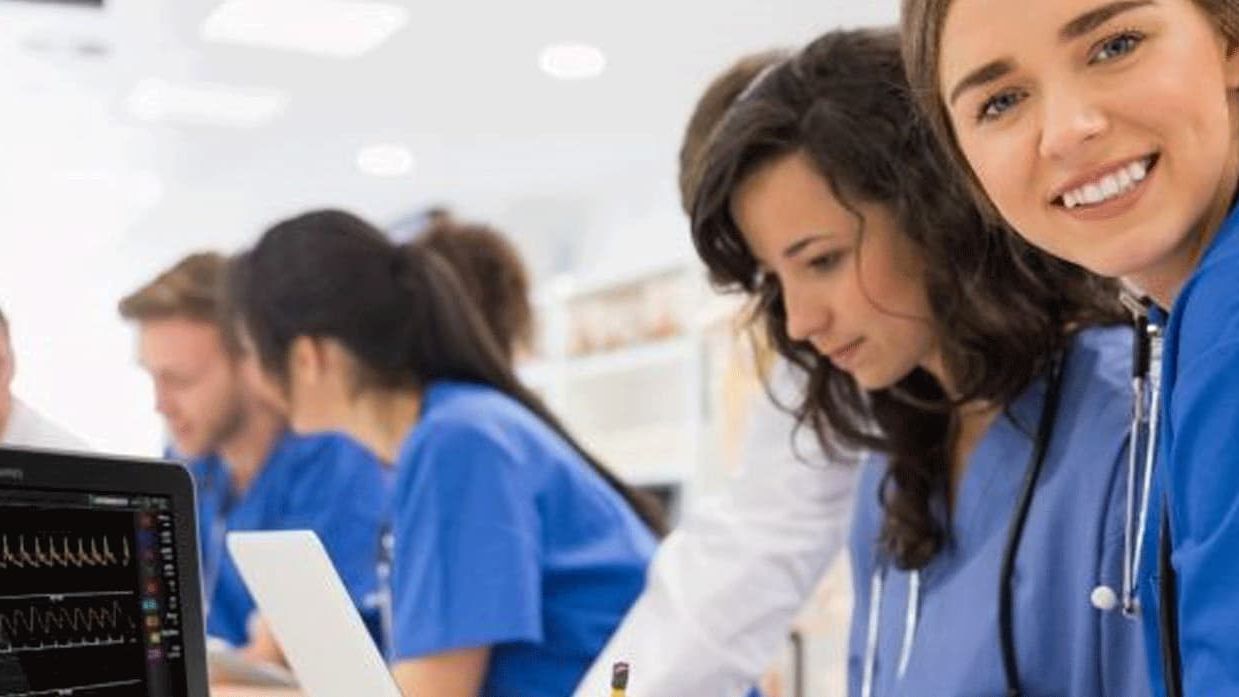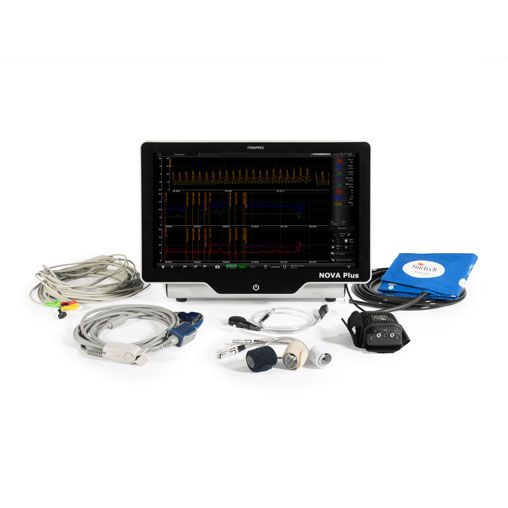Finapres®, an Innovative History: Research, Development, and Validation of Continuous Non-Invasive Blood Pressure and Hemodynamics Monitoring
Date: 29th March 2021
Reading time: 8-10 mins.
Author: Gerard Langewouters, founder of Finapres

Volume Clamp Technology: The Method to Non-Invasively Measure Finger Blood Pressure
The history of Finapres dates back to 1967, when the Czech physiologist Jan Peñáz invented the volume clamp method for unloading the finger arteries by applying external pressure to the finger. Using a cuff with an inflatable bladder enabled non-invasive finger blood pressure measurements. In 1973, Prof. Peñáz demonstrated a proof of principle device on a conference in Dresden, Germany [1]. This device required expert knowledge to manually detect the correct setpoint. In many cases, the volume-clamp technique became an alternative for invasive intra-arterial measurements [2].
Want to learn more about the benefits of the volume-clamp technology? Read Finapres blog # 2: “5 Benefits of Continuous Non Invasive Blood Pressure Monitoring”
Finapres Device: the First Continuous Non-Invasive Finger Blood Pressure Monitor
In 1976, the Bio-Medical Instrumentation unit (BMI) of TNO, the Netherlands Organization for Applied Scientific Research, started a project that resulted in 1984 in the first Finapres® device: the first-ever continuous non-invasive finger blood pressure monitor based on the volume clamp method of Peñaz.
Physiocal® Enables Signal Calibration
Major breakthroughs were achieved due to the availability of microprocessor technology and the invention of the so-called Physiocal® criteria for the establishment and maintenance of the correct setpoint by Prof. Karel Wesseling, head of the BMI unit. Physiocal® enabled dynamic adjustment of the setpoint so as to maintain correct vascular unloading. This automated physiological calibration makes it possible to keep track of the correct level of the continuous non-invasive finger blood pressure, even during changes in vascular tone of the finger [3].
Finapres Contribution in Syncope Research and Other Application Areas
In 1984, TNO made a license agreement with the US-based company Ohmeda Monitoring Systems (Englewood, Colorado) in order to make the Finapres® technology available to researchers and clinicians. Ohmeda launched the Finapres 2300 device at the ASA meeting in San Diego, USA in 1986 where it became the talk of the show. Ohmeda successfully introduced the Finapres® technology in the medical community, with interest mainly from the research market which generated many publications in areas that formerly only could be covered by using invasive arterial blood pressure measurements. Thereby, Finapres® largely contributed to major revisions or physiological textbooks, eg in the area of research syncope, due to the application of the Finapres® technology by many researchers and clinicians at leading hospitals and research institutions.
Ongoing Developments at TNO-BMI
The pioneering group of scientists and engineers at TNO-BMI continued developing innovative methods for non-invasive measurement and monitoring of blood pressure and hemodynamic parameters.
The major developments were:
- Portapres®, the portable Finapres® device
- Special products for space agencies
- Model Flow® to monitor Cardiac Output
- Brachial artery pressure reconstruction (reBAP)
- Return to Flow (RTF) calibration
1. Portapres®: the Portable Finapres®
A major milestone in the history of Finapres is the development of Portapres®, the portable version of Finapres®. The Portapres® project was headed by Gerard Langewouters. Using state-of-the-art technology at that time, major components of the device were miniaturized, made lightweight, and battery operated. The Portapres® device was also equipped with an innovative hydrostatic height correction unit to allow measured subjects to freely move the measured hand without introducing hydrostatic pressure errors. After completing a successful clinical study [4], Portapres® was made available by TNO to researchers and clinicians as of 1995.

Finapres Portapres® : The Portable device of Finapres
2. Finapres® Devices for Space Agencies: NASA, ESA, and CNES
The Portapres® development was also the basis for the development of innovative Finapres® products for space agencies, such as NASA, ESA and CNES, and many other research institutions around the world. Those products were used in the former MIR station (launched 35 years ago by the Russians) and, among many others, the Dutch astronaut André Kuipers has performed physiological experiments with these devices in the currently operating NASA International Space Station (ISS).

André Kuipers (right), the third Dutch astronaut, wearing a Finapres® device in space
3. Modelflow® Algorithm Enables Cardiac Output and Total Peripheral Resistance
A major development in 1993 was the invention of an innovative method to derive the aortic flow waveform from the blood pressure waveform by using a three element Windkessel model [4]. This so-called Modelflow® algorithm allowed the computation of a range of hemodynamic parameters, such as cardiac output and total peripheral resistance in addition to the blood pressure and heart rate parameters derived from the blood pressure waveform [5].
4. Brachial Artery Pressure Reconstruction (reBAP)
In 1997, an algorithm was developed to derive the brachial artery pressure waveform (reBAP) from the finger blood pressure waveform (fiAP), using an inverse filtering technique. This created the possibility to display blood pressure parameters based upon the brachial level instead of the finger level [6]. An additional level correction algorithm increased the accuracy to comply with the AAMI / SP-10 (currently ISO 81060-2) standard for blood pressure accuracy, except for systolic pressure [6-7].
5. Return to Flow (RTF) Calibration
Another important development in 1997 was the RTF calibration technique, to inflate and deflate an upper arm cuff in a controlled manner. This made it possible to determine the actual systolic pressure in the brachial artery based upon the monitoring of the finger pressure pulsations. This is based on the principle that finger pressure pulsations disappear when the pressure in the brachial cuff is higher than the actual systolic pressure, but reappear when the pressure in the upper arm cuff is deflated. In this way the reconstructed brachial pressure (reBAP) is calibrated using the thus measured brachial systolic pressure. This additional calibration made it possible for Finapres® devices to comply with the AAMI / SP-10 / ISO 81060-2 standard for all blood pressure parameters [8].
The majority of the developments mentioned above were implemented in the later innovative products such as the Portapres®, the Finometer®, and the BeatScope® software. TNO aimed at making the Finometer® and other products available to the medical market through an independent company.
Foundation of Finapres Medical Systems BV
In 2002, Gerard Langewouters founded Finapres Medical Systems BV and closed a license contract with TNO with the goal to make the ground-breaking Finapres® technology available to the medical community (researchers, clinicians and patients).
The Finometer® PRO with RTF calibration was launched in 2002 as the first ever product providing absolute accuracy to diagnose hypertension using beat-to-beat non-invasive blood pressure monitoring. In 2006, the Finometer Model-2 (MIDI) developed by Finapres Medical Systems BV was launched as a trending device, together with the PC-based BeatScope® Easy Software program for monitoring the measurements on a PC. The Finometer® MIDI has been used quite extensively in the area of syncope diagnosis.
Partnership with DEMCON
Finapres® NOVA: Continuous Non-Invasive Blood Pressure Monitoring
In 2009, Finapres Medical Systems closed a partnership with Demcon Advanced Mechatronics for the innovative development of the next generation Finapres® products. In 2011, Finapres Medical Systems BV became part of the DEMCON group. The cooperation with Demcon resulted in the development of the innovative Finapres® NOVA monitor which was launched in 2015. The Finapres® NOVA gradually took over the role of the Finometer® devices [9, 10].

Finapres® NOVA for continuous non-invasive blood pressure monitoring
Finapres® NANO CORE® technology
Meanwhile, further innovation of the Finapres® technology proceeded at Demcon & Finapres, resulting in the development of the miniaturized NANO CORE® system that is currently used as frontend unit in combination with the Finapres® NOVA monitor. The Finapres® NOVA with NANO CORE® technology was Launched in 2017.

Finapres® NANO CORE® technology
Finapres Medical Systems BV in 2021
Since the foundation of Finapres Medical Systems BV in 2002, the company has evolved into a market-driven company with the purpose of making non-invasive hemodynamic monitoring a reality in daily clinical practice by providing the Finometer®, Portapres®, Beat Scope®, and the Finapres® NOVA with NANO CORE® technology available to the medical community.
The Finapres® NOVA can be combined with multiple (software) applications such as NOVAscope®, Advanced Hemodynamics, Autonomic Testing, and Guided Autonomic Testing!
Finapres® Guided Autonomic Testing (GAT)
Finapres Medical Systems BV continues to develop innovative technologies to further characterize the cardiovascular system that can be used in various (pre-) clinical disciplines, such as Physiology, Cardiology, and Neurology.
In 2020, Finapres launched the Guided Autonomic Testing (GAT) application as part of the Finapres® NOVA, which guides the operator and the patient through a series of autonomic test maneuvers (Valsalva test, Stand test, Deep Breathing test, Tilt Table test, Cold Pressor test, Carotid Sinus Massage test, and Drugs Administration test). The GAT application consists of a graphical user interface on the NOVA and also includes a tablet. The tablet provides instructions for the patient during the tests and has the ability to record a video during the test. Upon completion of the test, the application generates a PDF report with quantified results of all performed tests. Together, all these features support the standardization and quantification of autonomous tests!
Learn more about Finapres solutions at www.finapres.com or request for quote for more information!
More questions? Contact us!
References
- Peñáz, J “Photoelectric measurement of blood pressure, volume and flow in the finger”. Digest 10 th Int. Conf. med. bio. engng. 1973
- Langewouters, GJ et al. “Why use Finapres or Portapres rather than intraarterial or intermittent non-invasive techniques of blood pressure measurement?” Journal of medical engineering & technology 1998
- Wesseling, KH et al. “Physiocal, calibrating finger vascular physiology for Finapres” Homeostasis 1995
- Imholz, BPM et al. “Feasibility of ambulatory, continuous 24-hour finger arterial pressure recording” Hypertension 1993
- Wesseling, KH et al. “Computation of aortic flow from pressure in humans using a non-linear, three-element model” Journal of Applied Physiology 1993
- Bos, WJW et al. “Reconstruction of brachial artery pressure from non-invasive finger pressure measurements”. Circulation 1996
- Gizdulich P & Wesseling KH. Reconstruction of brachial arterial pulsation from finger arterial pressure Proc 12th Ann Int Conf IEEE-EMB 1990
- Guelen, I et al. “Finometer, finger pressure measurement with the possibility to reconstruct brachial pressure” Blood pressure Monitoring 2003
- Looney, J. et al. “Childhood Adversity Impairs the Autonomic Response to Acute Stress.” The FASEB Journal 2019
- Greenlund, IM et al. “Sex differences in blood pressure responsiveness to spontaneous K-complexes during stage II sleep.” Journal of Applied Physiology 2020




